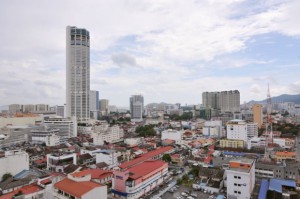Massive projects in place to alleviate urbanisation in Penang
 If you feel that Penang, especially the island, is getting crowded you are absolutely right.
If you feel that Penang, especially the island, is getting crowded you are absolutely right.
According to the Department of Statistics, the level of urbanisation in Penang at 90.8 per cent is among the highest after Kuala Lumpur, Putrajaya and Selangor.
The population density of the northern state is also high at 1,490 persons per square kilometre in 2010 as compared to the most populous state, Selangor, that only has a population density of 674 persons per square kilometre. Nationally, the average population density stands at 86 persons per square kilometre.
If we look at the population distribution between the island and the mainland, almost half of the population is concentrated on the island, which is 45.8 per cent of the approximate 1.6 million people in the state as at 2012.
“There is no question that Penang is one of the more urbanised states in the country and one of the focus of urbanised states is the needs of housing,” said Town and Country Planning and Housing committee chairman Jagdeep Singh Deo in an interview with Malay Mail Online.
He said the need to address housing issues is quite acute and with urbanisation, there is also another issue to resolve ― traffic congestion.
Spreading out from the island
Highly aware of the rapid development and resulting urbanisation of the island, the Penang state government launched several projects to spread out the population and to resolve the traffic congestion that has become a major problem in recent years.
According to Jagdeep, the state government launched its affordable housing projects in all five districts of the state ― northeast district and southwest district on the island, North Seberang Perai, South Seberang Perai and Central Seberang Perai.
“To date, we have 14 projects in all five districts but if we look at the numbers, Seberang Perai has the largest share of projects in all five districts,” he said.
He said there is a need to spread out housing projects to districts other than the northeast district which is George Town where the main city and the Unesco Heritage Zone lies.
“Although the island has attracted many private sector developers, it is not necessarily the case that none are interested in Seberang Perai as I have seen many developers applying to build projects on the mainland now,” Jagdeep said.
This shift to the mainland could be due to two main factors ― lower land costs on the mainland and the scarcity of land on the island.
Jagdeep believes that there will be a natural spread of projects and the population to the mainland in the long run as projects increase there.
According to Think City’s chief operating officer Dr Neil Khor, the population at Central Seberang Perai is currently high but the land use is inefficient so there is a need for a detailed development plan to maximise efficient land use.
Think City is currently undertaking an urban regeneration project in old town Butterworth, a portion of Central Seberang Perai. The district has the second highest number of population, of about 380,300 as compared to 733,600 for the whole island.
“The whole idea of releasing the pressure of urbanisation in George Town is to spread it out and gentrification is moving to Butterworth,” he said.
Khor said Think City is working together with the Seberang Perai Municipal Council to come up with a plan-led approach in reviving the old town and encouraging a more organised development of the area.
“We are looking at projects that go in tandem with the local plan and structural plan and while we can’t go in to improve the existing public housing projects here, we could improve the public spaces such as parks and a clean seafront for people,” he said.
Batu Kawan and South Reclamation Scheme
Batu Kawan is one of the sites that the state is focusing on to develop and become a natural site for the population to spread out to.
“The first phase of Bandar Cassia will be ready in December this year, there are already existing industries there and commercial outlets like Ikea is also coming up, soon we will see Batu Kawan coming up much like what happened to Taman Tun Dr Ismail in Kuala Lumpur,” Jagdeep said.
He believes that it will be a natural phenomenon as once these commercial and residential aspects slowly take shape, many will start to set up and live there.
“This is an answer to the saturated urbanisation that George Town is seeing right now,” he said.
Another area to look at is the proposed South Reclamation Scheme (SRS) project on the southern side of the island where three man-made islands will be reclaimed to provide 4,500 acres of land space.
“These three islands will have three components ― industrial to cater to the free industrial zone, commercial and residential,” Jagdeep said.
He said the state government has agreed to allocate more than 25 per cent of the residential components on the three islands to affordable housing.
“I am still trying to negotiate for more affordable housing units there but I am happy that at least 25 per cent has been allocated for this category,” he said.
The SRS is part of the state’s planned Penang Transport Master Plan (TMP) as it is meant to fund the ambitious RM27 billion project.
Addressing housing woes
While projects are underway in all five districts, there are also other measures that the Penang state government put in place to meet with current housing needs.
One of it is the increase in density for housing projects from 30 units per acre to 87 per acre only for certain areas on the island. There are also certain areas that allow a density of up to 180 units per acre.
However, there is a catch to this increased density as only affordable housing projects for housing priced below RM300,000 can apply for such high density, said Jagdeep.
“We only allow higher density developments for affordable residential projects, we don’t want developers to reap profits from higher density projects,” he said.
Also in the works, in tandem with the state’s planned TMP, is a form of development called the transit oriented development (TOD) where density could even be higher than 180 per acre.
An example of TOD is KL Sentral where commercial, residential and industrial developments are located in one area and are connected by a transit point.
“If we look at the main line of the LRT under the TMP, we can have TOD along the alignment especially at main stations along the line,” he said.
The rationale is that with an LRT line, it takes away the need for private vehicles so even with higher density at TOD projects, it will not affect the traffic in the area.
Resolving traffic congestion
Traffic congestion is probably one of the major issues that comes with urbanisation, particularly on the island side of the state.
“That is why we have the TMP which is spearheaded by Chow Kon Yeow and it is now in the planning stage,” Jagdeep said.
In the long run, the comprehensive transport plan that includes a connected network of LRT lines, bus routes and also monorails, will make Penang more connected while at the same time, alleviate the growing traffic congestion problem.
Jagdeep said the state can’t allow higher density for housing if the traffic can’t cater to it so most housing projects are heavily dependent on the traffic impact assessment.
That being said, Jagdeep believes that more of the population will slowly spread out from the northeast district in the island as the southwest district is now facing rapid urbanisation with more projects coming up.
“I can foresee that there will be further sprawling and overflow to outside the currently popularly dense area once it reaches saturation point,” he said.
As it is, due to the increasing costs of housing and rental within the Heritage Zone of George Town, many are moving out of the core zone to surrounding areas.
According to Khor, if calculated based on population, Butterworth has double the number of people as compared to the Heritage Zone due to the recent evictions and relocation of inner city residents.
“Butterworth has a higher density and as gentrification moves this way, we can see that urbanisation will have spread here too,” he said.


Ya, We need subway.
we really need well planned & practical kind of transport system.